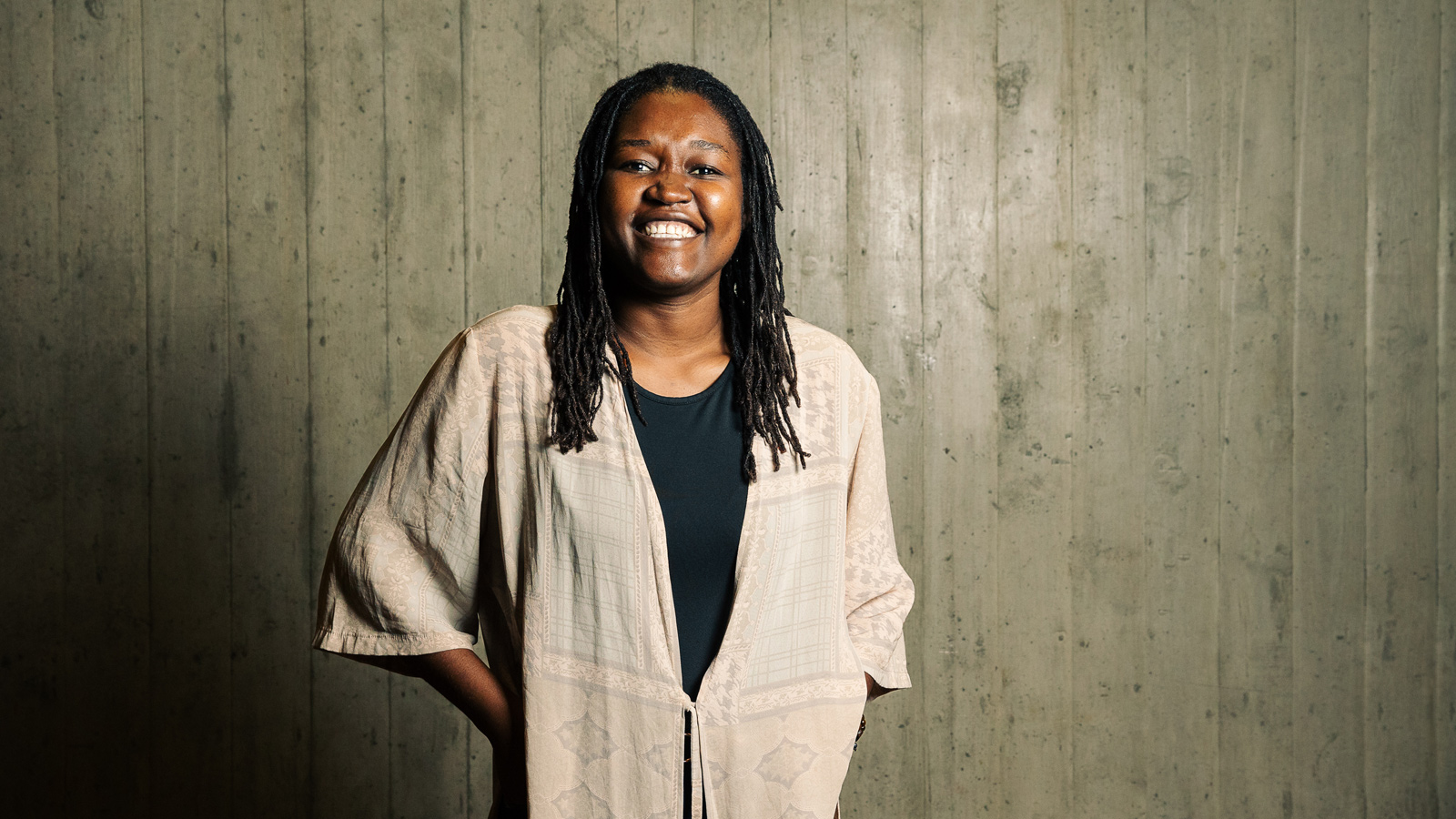‘That’s what art does. I feel it’s a very beautiful way of transforming people’
What made you want to take part in the Youth Advisory Group? What were you expecting when you applied?
The text of the advertisement was very interesting, in the way it was put together and also in what it said: they wanted young people who had an active life in terms of civic participation in projects, not just cultural projects, but democratic ones too. And it caught my attention straight away – I’m not Portuguese, I’m from Angola, and I’ve only been here for a relatively short time – but in Angola I’d been involved in activism and human rights for about two years.
I didn’t know exactly how I would fit in because, as I said, I’ve only been here a short time. I thought it might be a very different reality to mine. But even so, when I arrived [in Portugal], one thing I did straight away was look for associations and to join people who worked with human rights and reflected on society from the point of view of diversity, equity and justice.
Honestly, I didn’t have many expectations of being able to take part, I thought – I think we all thought: it’s the Calouste Gulbenkian Foundation, I’m not going to be chosen… very much the idea that the Foundation would be this whole sophisticated structure, and that’s a bit scary.
As I said, my expectation was to learn, because I knew that if I was selected, I would probably be in a group that was very diverse and high quality. So my expectation was to learn from these people, but also to learn from the people I would meet here at the Foundation. But I also wanted, in some way, to bring my vision, and all that I have experienced of working in human rights activism, but also in the cultural area. Because that’s an area the Foundation works with, and I have experience of working with libraries, literature, and from that I work a lot with culture.
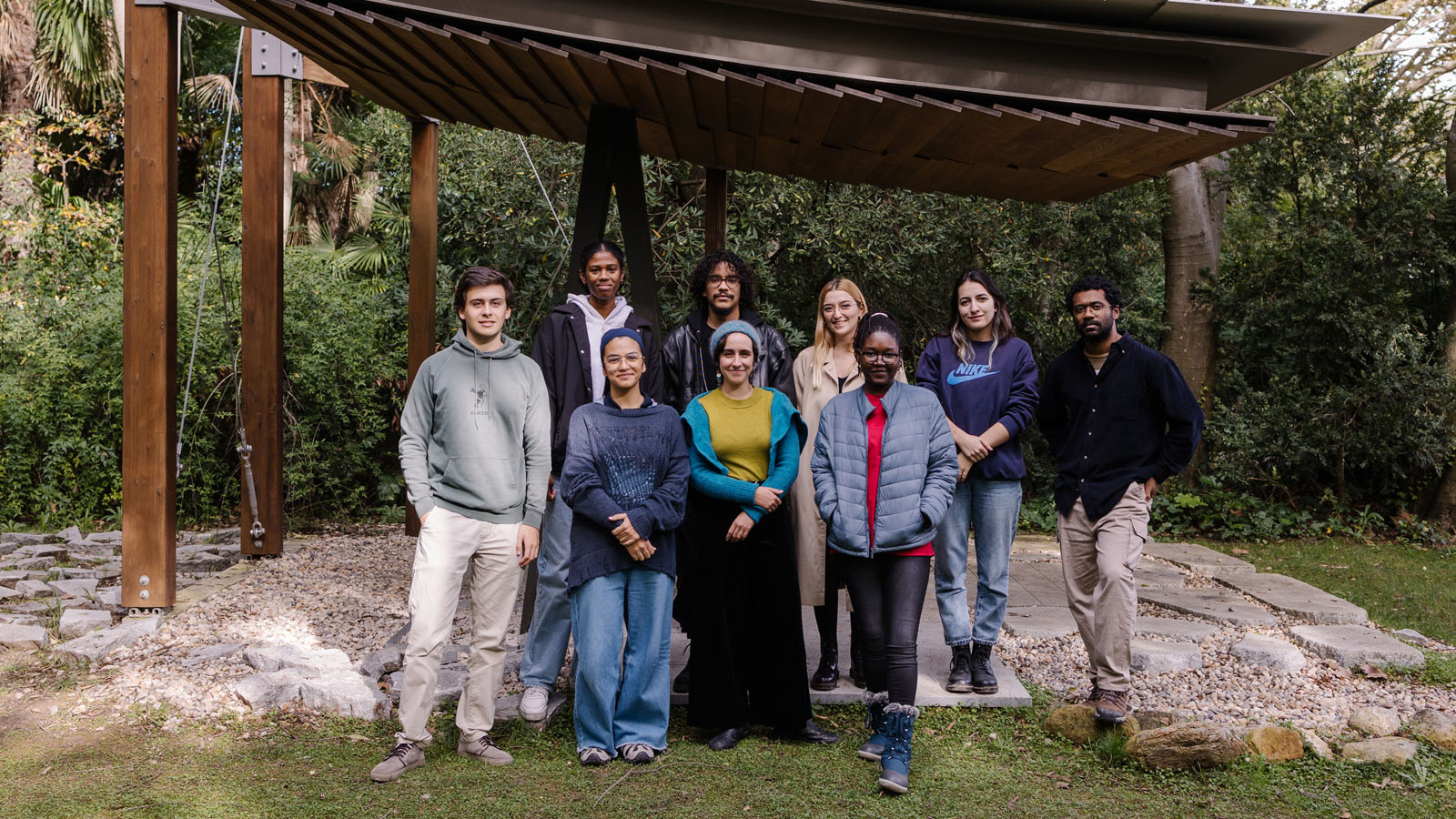
You’ve been on the Advisory Group for a few months now. What have been your favourite moments so far?
There’s been many… The work we’ve done with some of the teams. Some of the sessions, for example, working with the Live Arts team and the Collection team. With the Collection, it was more about getting to know the collection, but also discussing it a bit and finding out how the team works. It was very interesting for me because I didn’t have much idea beforehand.
Then there was the Live Arts team, which was one of our best sessions because we were able to think about very practical, very concrete things, and also because the work was very stimulating. The proposals – what the team sets out to do – are very interesting for young audiences and also for us. That was one of the things that struck me most. But in general the whole journey has been very interesting.
One of the things that has been fundamental for me is to feel, in some way, the openness on the part of the teams and the people we’ve met to talk about their work.
Often we’re with teams that have their own working dynamics, that have a history. And when people have been working on something for a long time, there are established habits. And to feel this openness on their part to listen to a group of people who come from outside, who perhaps don’t have as much idea about what they do, is very positive and I think that’s what struck me the most, because I value dialogue so much.
There’s one more thing that struck me: we did a session with Sepake [Angiama]. She did a session for the public, but there was a first session with just the CAM team. It was marvellous. I think I even cried with emotion at the things she was saying. She works a lot with education and I’m a teacher by training. And she said some very important things, she talked about challenges that, when you listen, you realise are common.
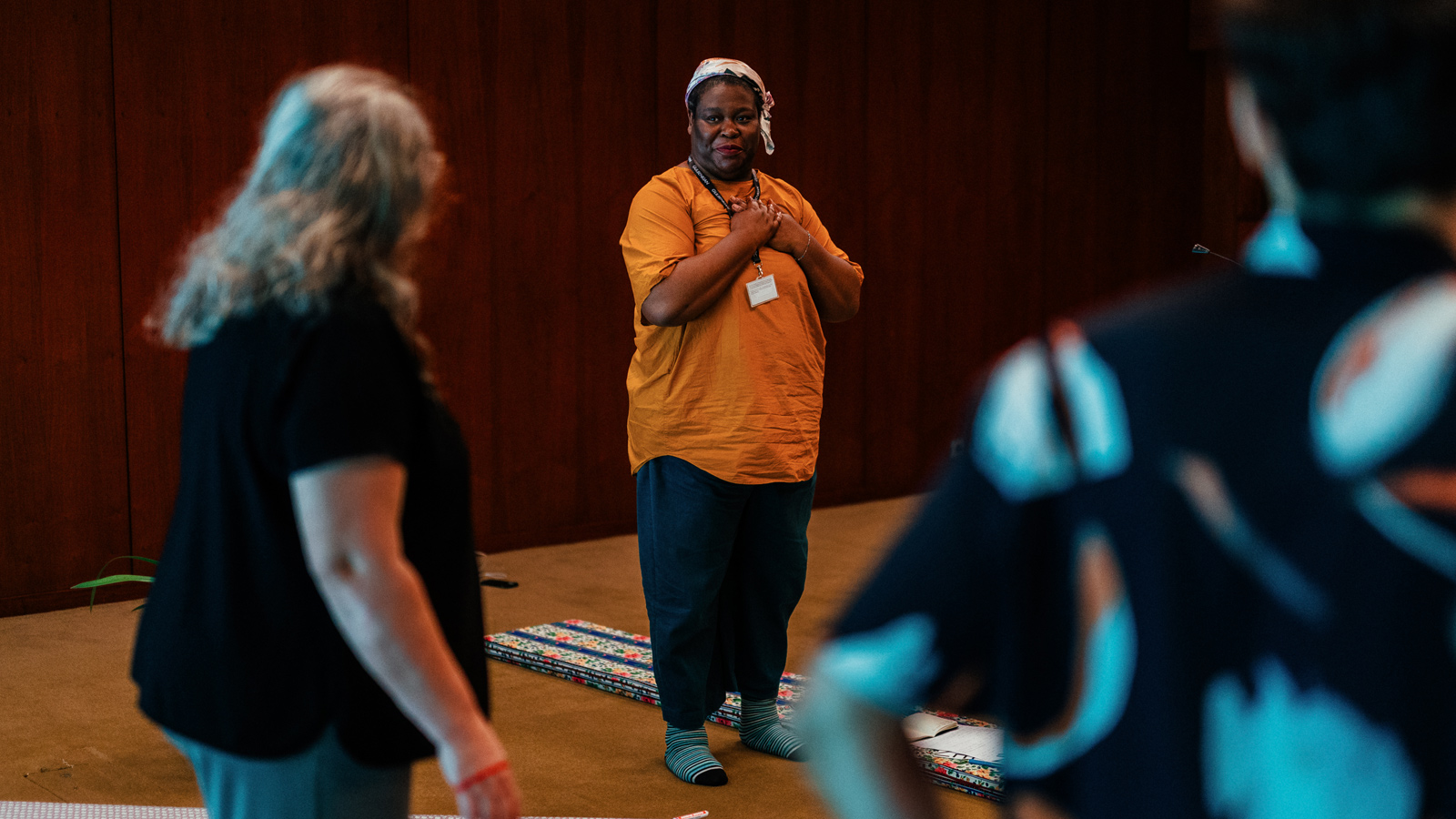
Sometimes you’re in Angola or Africa and you think the challenges depend on that context. But to hear her talk about the reality of England, which is where she works, and about the importance of us questioning our own structures, in terms of education and the programmes we receive, and trying to find more creative ways of working with that, above all, relating it to art… for me it was very moving because it’s work I’ve always tried to do as a teacher, and so that was something that struck me.
You were a literature teacher in Angola. How do you think that experience taught you about learning art? How can this be linked to the work of a museum?
I think that the museum here, the Foundation and the CAM, both do a very important job from the point of view – I don’t know if I’m using the right word – of ‘educating,’ but also of democratising access to art and culture. Which is something that, for me, as a literature teacher, in the classroom, I fought to make happen. I felt that a lot here. The work the museum does, the events it organises, the activities it offers.
For example, I feel there’s a very strong connection and also a great commitment to involving schools. Especially primary schools. Sometimes, when I pass through I see lots of children and I think it’s very nice to have children here, from a very early age, in this process of interacting with museums, of having contact with art, of thinking about the world from other perspectives through what they find here.
So I think the work being done here is very much linked to things I believe in, things I was even trying to do. I’ve been collecting ideas here for activities that I can carry out when I get back to Angola. For example, getting out of the classroom a bit and going outside more.
You’ve already mentioned the importance of activism for you. How can art be an important vehicle in this activism and in the fight for human rights?
I think it’s absolutely fundamental, because art speaks to us in ways that, for example, an academic article does not. Of course, this is not to devalue academic articles, which have their value. But art has a much greater ability to speak to everyone, to all audiences. And to plant things – even if it’s not planting – to awaken people to certain issues.
If I sit down, for example, to read an article about women’s rights, the rights of racialised people, the rights of immigrants, or whatever, which is, I don’t know, 10 pages long, which can be very good and have a lot of weight, I can also listen to a song or watch a play.
I’m fascinated by theatre. I love the theatre. And every time I go to the theatre I hardly ever regret it. I think I’m lucky enough to choose good plays. The other day I went to see a play by Tiago Rodrigues, ‘Na Medida do Impossível’, and I was absolutely blown away, speechless.
So I think about how I wasn’t sitting reading an article, or reading a book, which is something I also love, I’m a literature teacher, but I saw a play and it was something extraordinary. It spoke to me in a very powerful way, and that’s why I think art is fundamental in this process of us fighting for rights. Because it’s another language, another way of reaching people. I think it’s a much quicker way, I would venture to say, to reach people and speak directly to their hearts.
The other day I was even talking to a friend about how I want to start exploring the path of writing about the role of love within human rights activism, because I feel it’s something we’re missing. In general, we are fighting, in the sense that we are fighting for things: we have all the vigour, we have to take to the streets, we have to shout, and that, of course, is absolutely important. It’s also important, fundamental, to occupy the street, public spaces. But I kept wondering what role love could play.
Talking about love and speaking to people’s hearts in our struggles. So I want to explore this path of starting to talk about love as a political practice within activism. And for me, art is a bit like that. It’s being able to talk about very important things, about justice, about rights, about equality, about diversity and all the barriers we face today, which is absolutely necessary, in short, in a poetic way, in a way that cuts through…
Art carries that love, too…
Yes! Exactly. It’s fighting with different weapons, which can be much more effective. As a literature teacher who works with teenagers in a very difficult context, I’ve seen my students progressively change many things within themselves, change their view of the world, their sensibility, their way of looking at things.
The way they arrive at the beginning of the first year, with very fixed, very concrete ideas about, for example, the role of a woman, the role of a man, and then arrive to the third year of classes, after having read so many other books and listened to so many other songs, their discourse changes. I don’t have to force it, to be a militant for the causes, just offer the books and songs. And they change.
That’s what I think art does. It’s an approach, a path… I feel it’s a very beautiful way of transforming people. It’s symbolic, and we often don’t see the results right away, it takes some patience and belief that what we’re doing will bear fruit.
The Advisory Group had the opportunity to take part in International Museum Day, programming some activities. In your case, I think you did ‘Qual é o Tea?’ Could you tell us a bit about this event?
It was marvellous. We were challenged to come up with event proposals for Museum Day. We’d already been here for a few months and one of our main roles is precisely to think with the CAM team about youth programming. We had a few days to brainstorm about things we’d like to do.
I had the idea of organising a Story Fair. Which then ended up materialising in ‘Qual é o Tea?’. All the ideas were very good, very beautiful, and some ideas even ended up combining with others. We put it all to a vote. The preparation process was very good, because we worked in teams, contacting people, talking to people.
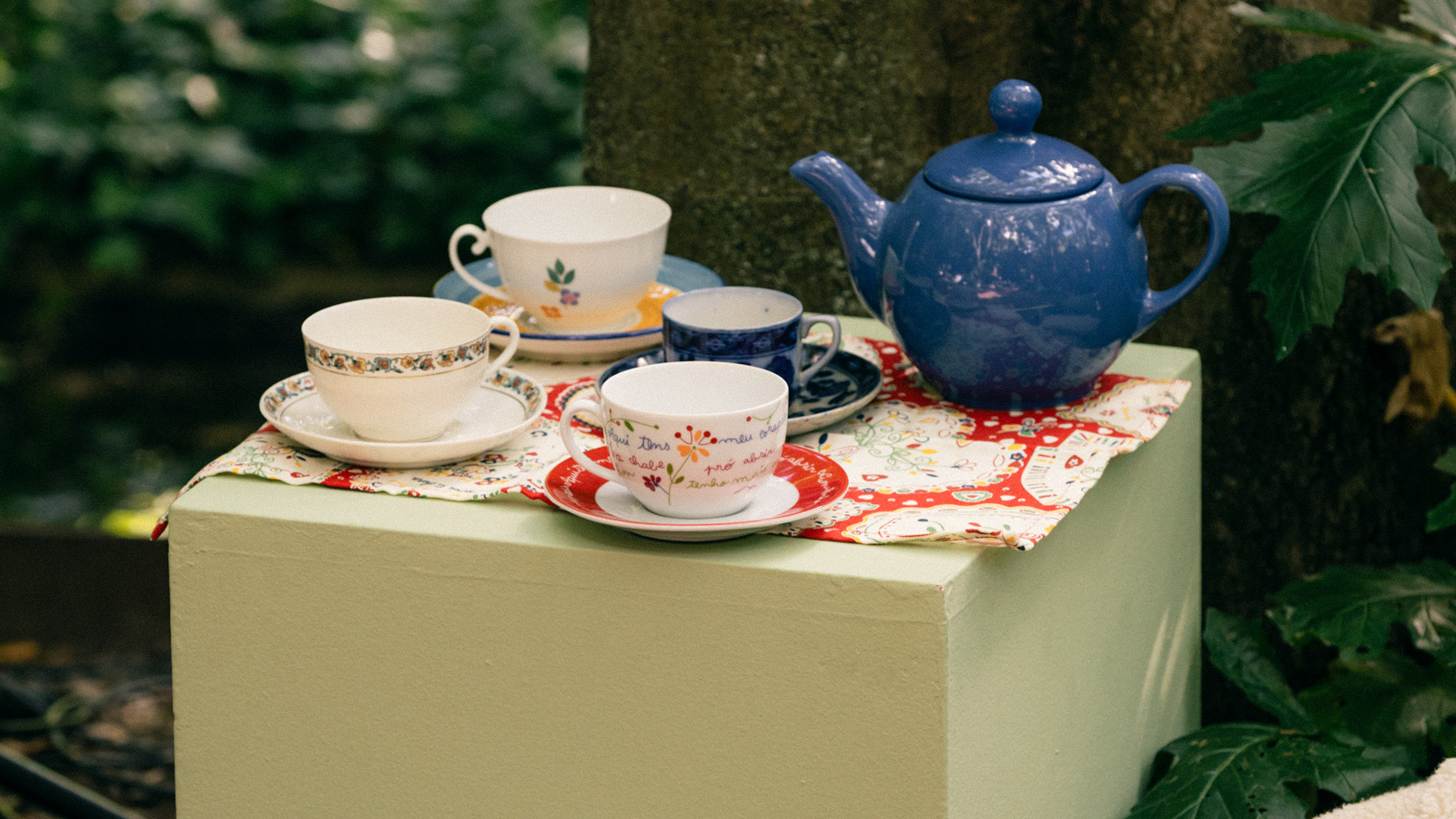
The initial idea behind ‘Qual é o Tea?’ was, from the outset, to have people who don’t know each other come together. We even talked about that the Saturday of the event. The idea was based on the fact that all societies – although not at the stage we are at today where other dynamics have been established – at some point in their history, even if it was only in the early days, and the books are there and tell us this, all societies had times in which oral sharing was fundamental. That’s how information was passed on and that’s how lessons were learnt. That’s how children were brought up and everything was built.
Some societies still preserve this in Africa. In Angola, in some towns in the interior, there are still places where people sit in a circle to tell stories.
For example, in my parents’ language, which is Umbundu, the place where people sit in a circle, which is more or less the shape of this room, to tell stories, is called ‘jango.’ Even today, in many communities there is still the structure of the ‘jango,’ which is a place where people sit down and solve community problems, chat and talk about their issues.
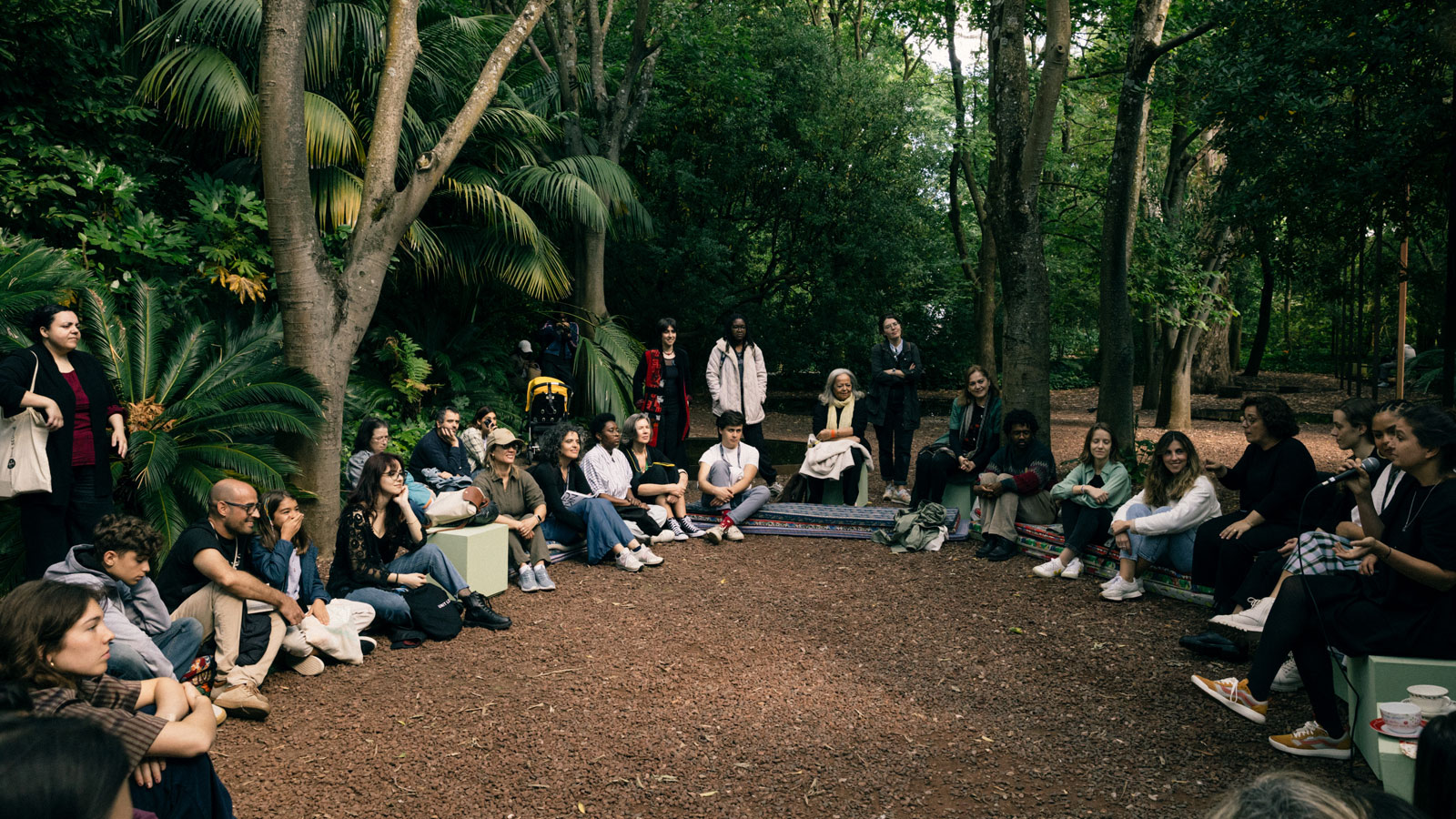
So ‘Qual é o Tea?’ came from this idea that we need to sit down and listen to each other more. Especially as our societies are becoming more and more polarised, with people taking opposing sides. With all the political issues, with the far-right and far-left movements, and all these things that are happening… We can feel that our ability to talk to each other, to listen to each other, is in short supply.
One of the main aims of ‘Qual é o Tea?’ was to work on listening: to sit there and just listen to the other person’s story, to absorb that story, to feel that story, and not to have to respond, not to have to rebut, not to have to comment, not to have to ask and say that it’s not quite like that, not to have to question, not to doubt… Just being there, listening, listening to each other.
There were people who sat there for four hours, from the first to the last hour, listening, with a look of delight on their face, always with a great willingness to listen. Some people stayed for two hours, others for three, it was a very beautiful experience.
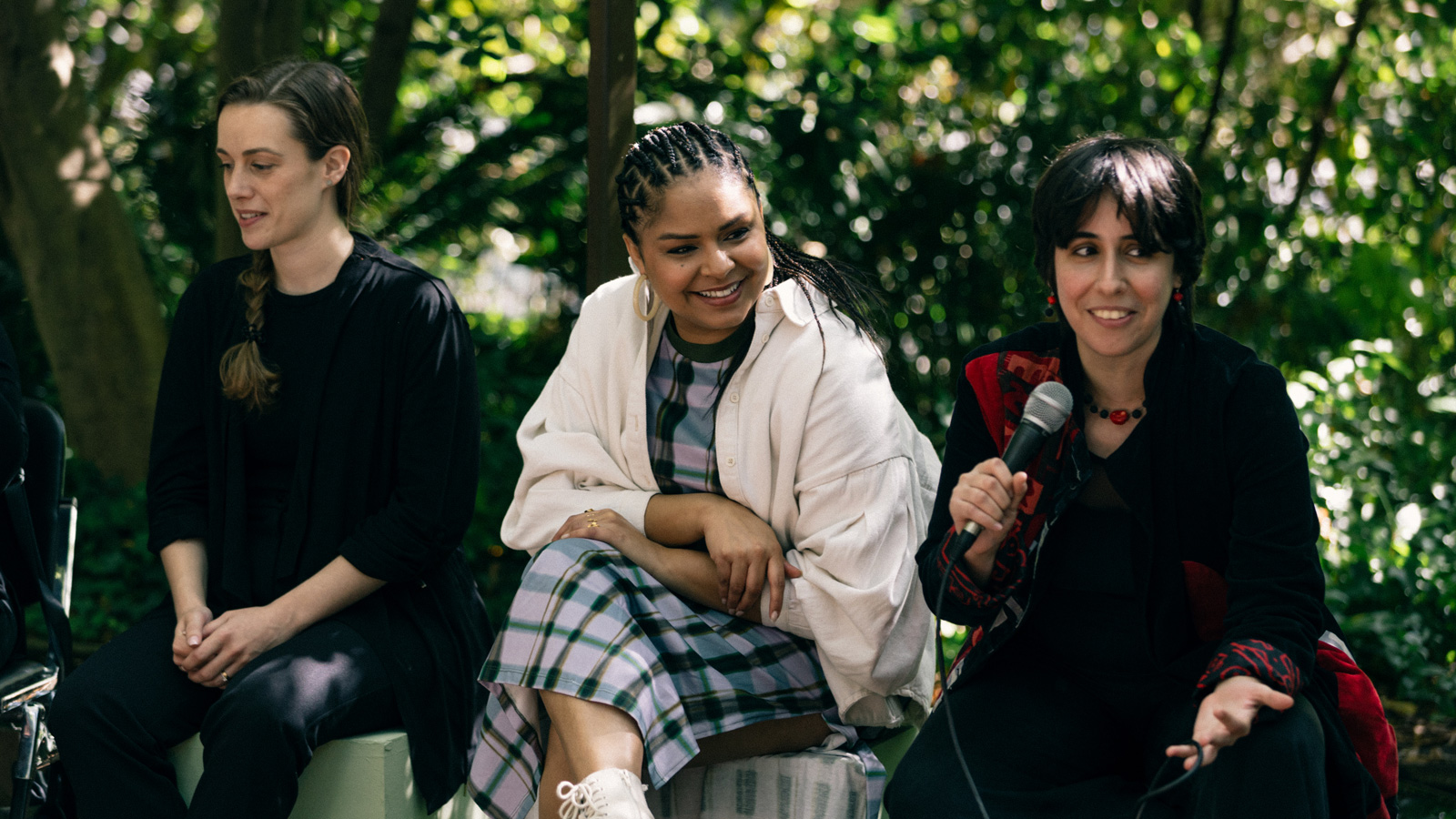
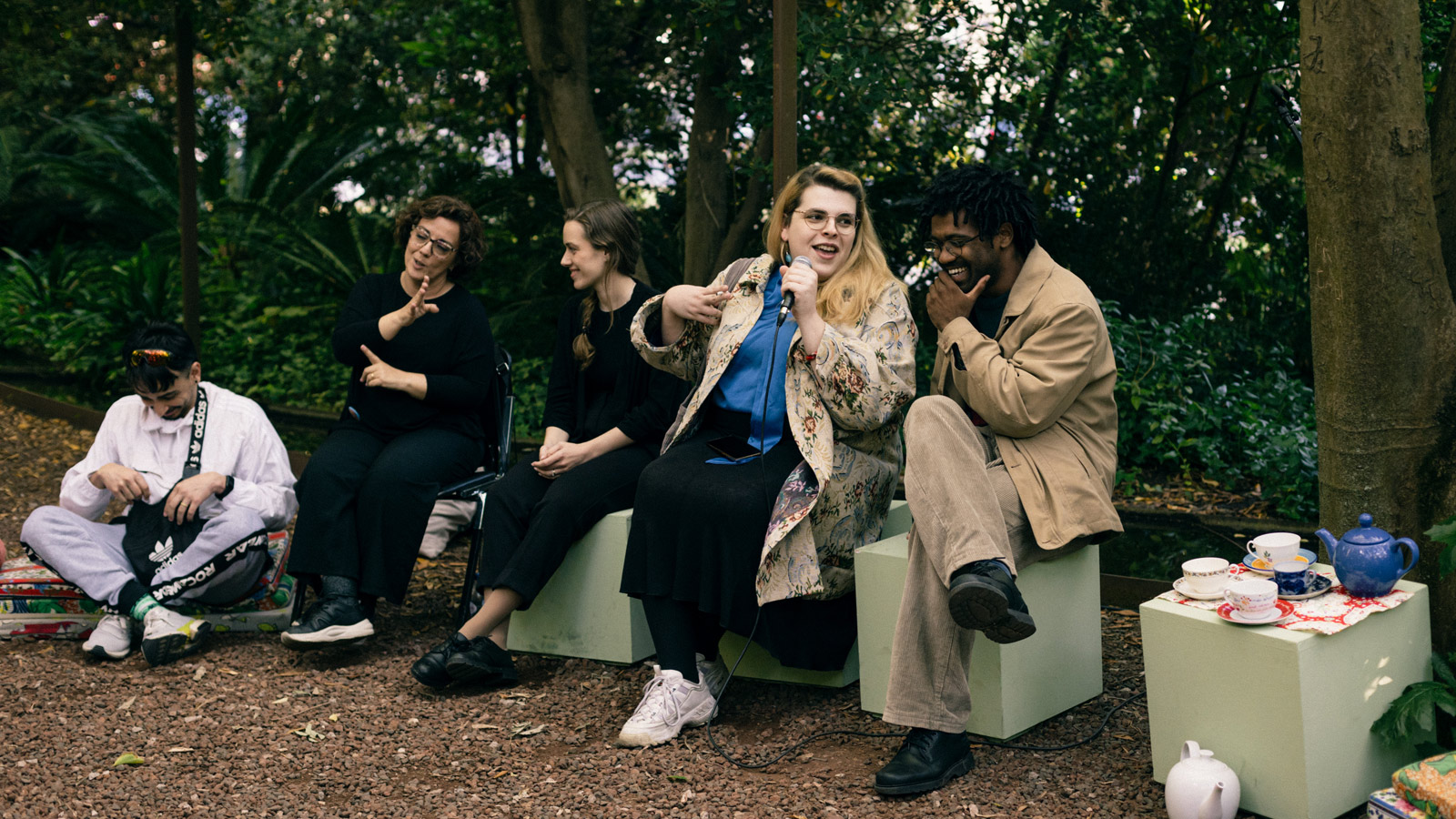
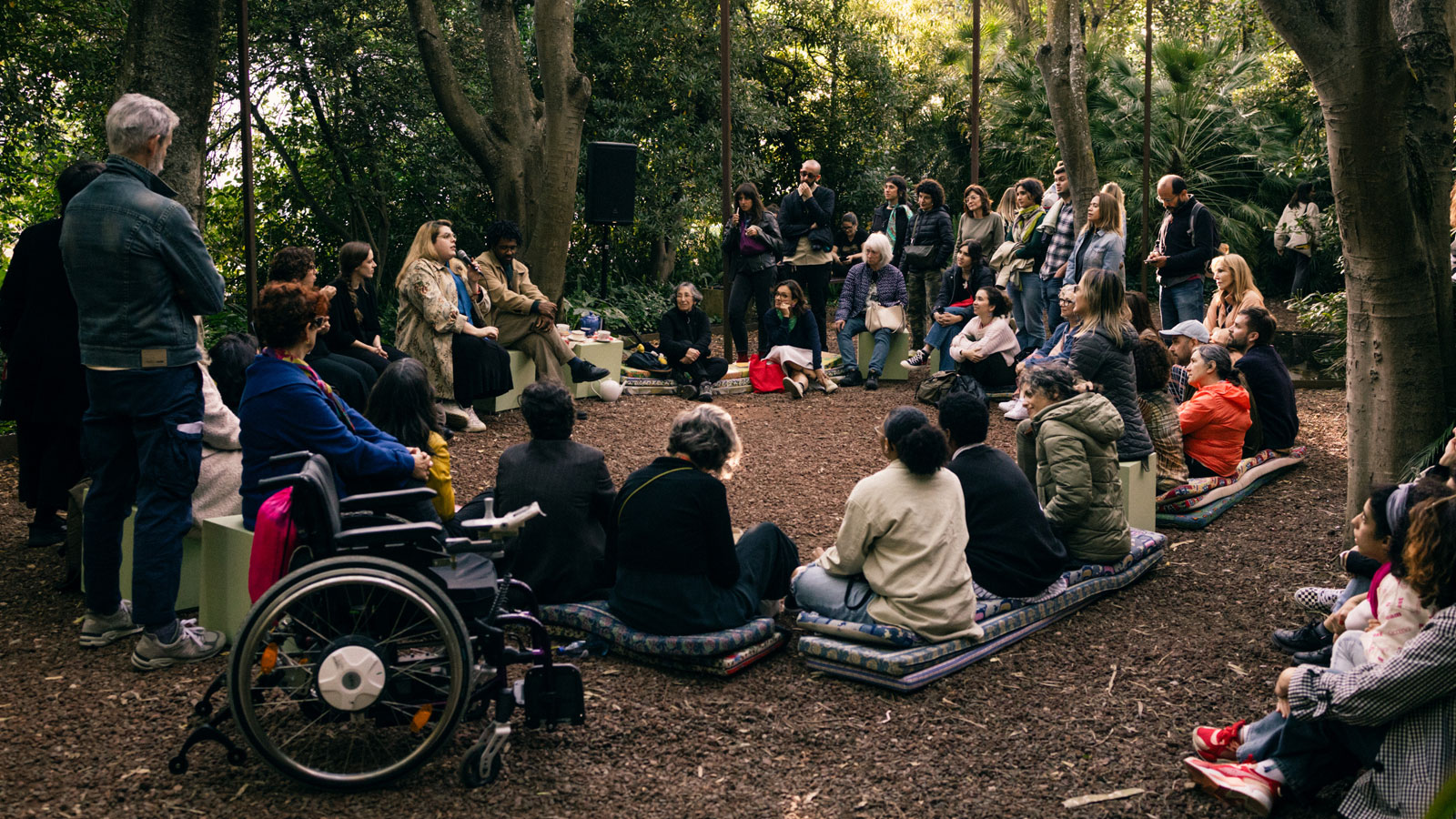
When you started the project, we asked you to choose two works from CAM’s collection: you chose ‘Modelo’, by Maria Antónia Siza, and ‘O fardo de cada um’, by João de Menezes Ferreira. Why these two?
Maria Antónia Siza’s work was… I was looking for a work and we had to choose from among the 12,000 works in the collection, I don’t know – and I didn’t get to see everything, I confess – but I saw a few and when I got to this one by Maria Antónia Siza, it was love at first sight. I loved it. Why? Because when we look at a work of art, when we read a book, who we are, what we think and the things we believe in have a very big influence on how we analyse the work. And I think it also comes from the fact that I’m a feminist.
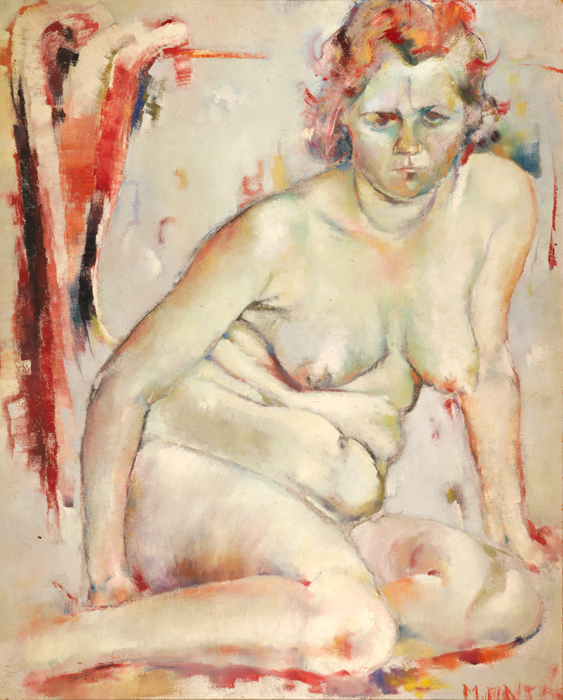
The painting depicts a naked woman sitting down, a real woman. You can see that it’s a woman who is getting older, in other words, in that picture and in that woman, you have the marks of time. Anyway, it’s not an ideal woman, it’s not a woman who doesn’t age, who isn’t affected by time. Because when we go out on the street on almost every corner we’re confronted with billboards advertising creams and more creams… The other day I was thinking about how creams to hide wrinkles are called anti-ageing! That really intrigues me. How anti-ageing? That doesn’t make any sense! People grow old. There’s no way to stop the course of time. It’s not possible! People grow old.
And the other one, ‘O Fardo’ [The Burden], also caught my attention because I feel… and we’ve talked about this among colleagues on the Group, as young people we increasingly feel pressure to be things, to be people who are always producing. Our societies increasingly function according to the logic and dynamics of overproduction. We have to produce, we have to be, we have to have, and all of this is a huge burden. It’s an enormous weight on us.
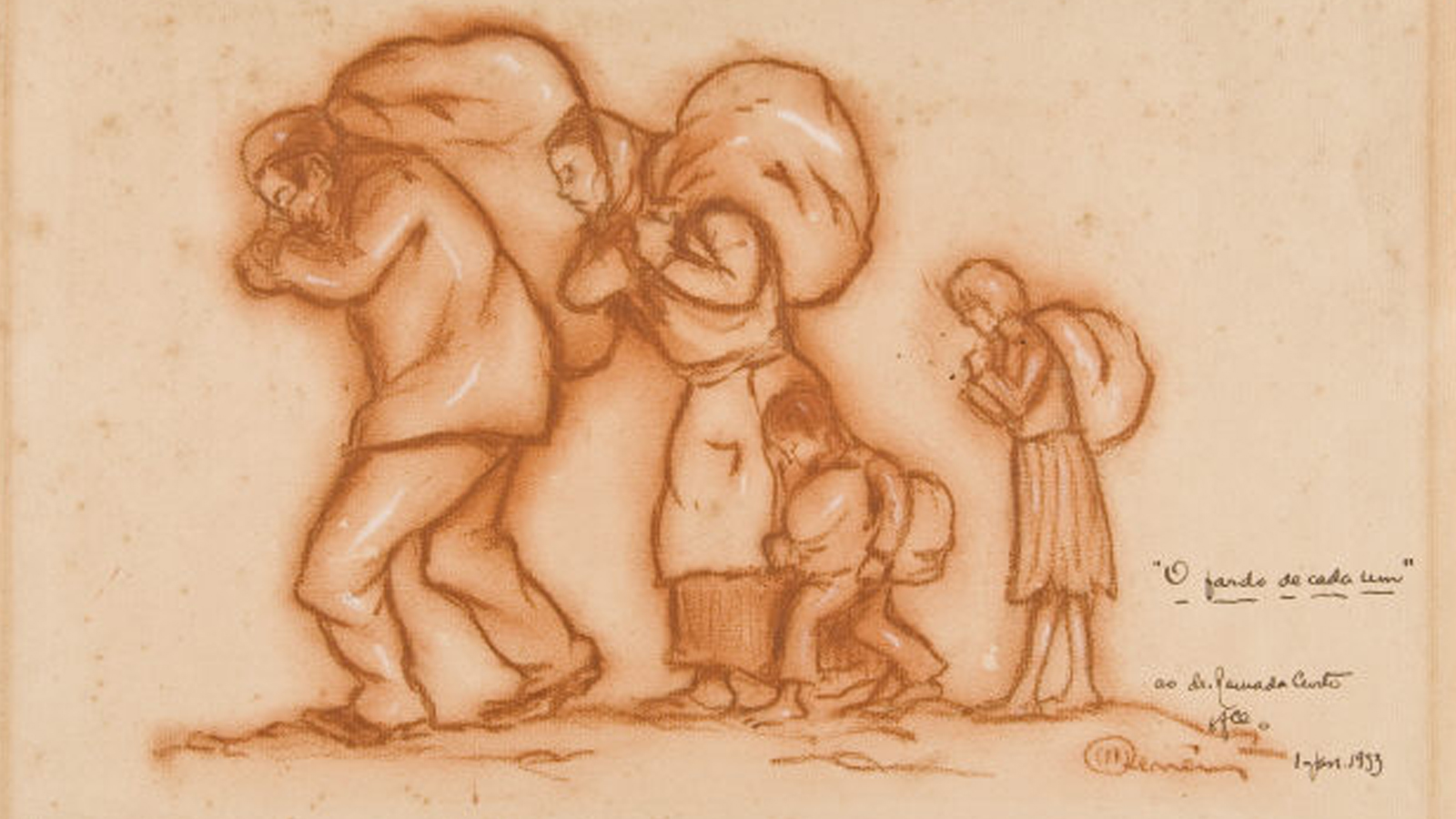
And at the same time, there are various social problems. For example, Portugal has a housing problem, and young people are wondering how they’re going to get a home. How are they going to get a job that allows them to have a house or a minimally stable life? At the same time, you have all these problems and a series of difficulties that make the path to getting a house and a stable life more challenging. On the other hand, you have a lot of pressure on you to be something. So when I saw that painting, which was a man, a woman and a child, with a burden on their backs, it brought to mind this idea and this pressure that we’re currently under.
And all of us, in some way, are carrying a burden. And, unfortunately, this starts from a very young age, with all these external pressures and stimuli. So I identified myself. I saw the picture and thought that I myself could be a person in that queue with a burden on my back, with thousands of things to carry. I saw myself in that picture because I also have my burdens. We all have our own and because we are all carrying things in some way.
Sometimes there are things that relieve us, like art, which for me is fundamental in this process of being able to carry our burdens and, more than being able to carry them, of reducing the weight they have on us. I thought about myself, but I also thought about the people I know, the people I socialise with, and the conversations I have with young people about our concerns and the suffering we feel with the way our societies are built and the pressure that we can’t fail, that we have no room to fail.
